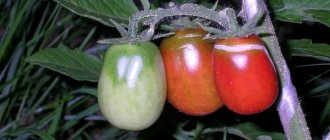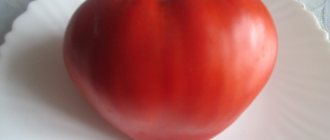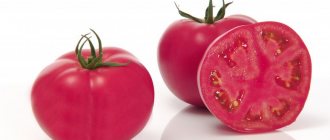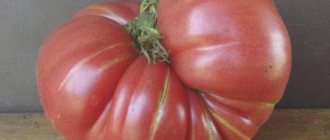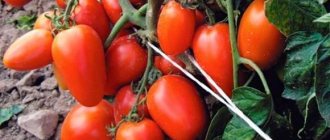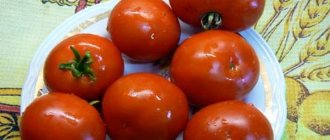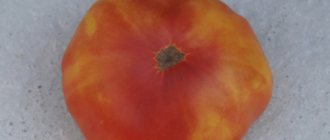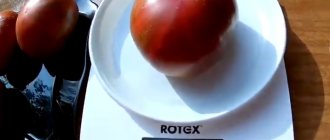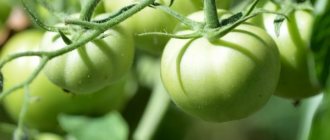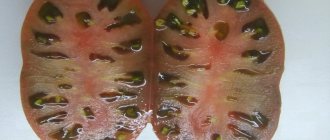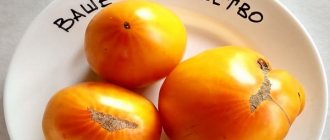The Florida Petit tomato was created in America. This is a very beautiful small bush, which in itself serves as a decoration for the garden bed, and its fruits combine decorative qualities and excellent taste.
| Height | Landing location | Ripening time | Fruit color | Fruit size | Origin | Fruit shape |
| short | Greenhouse, Open ground | Early ripening | Reds | Small | Variety | Round |
Description of the variety
Japanese dwarf is a tomato variety that got its name due to the short stature of the bush. This tomato is in no way connected with Japan, as it was bred by Kazakh breeders.
Despite the fact that this variety was bred a long time ago, it is difficult to find it on Russian markets. It is produced by . However, the advantage is that the seeds of its fruits are used for further growing tomatoes; it is not necessary to buy them every year.
Distinctive features of the Japanese dwarf
The main feature of the Japanese dwarf is the short stature of its bush. The plant reaches a height of only 30-55 cm.
The fruits of this variety are the most common. They are small and round. They are red in color and have dense but tender flesh. Read more about the appearance of the fruit in the photo.
The Japanese dwarf has a good taste for early-ripening tomatoes - rich, sweet with a slight sourness.
Another positive feature of this tomato is its ease of care. It is resistant to temperature changes and is able to grow in shaded areas. Thanks to this, its cultivation is possible in summer cottages.
The Japanese dwarf yields its harvest in the first half of summer. Thanks to this, he does not have time to get late blight. This variety has average resistance to other diseases characteristic of nightshade crops.
During the fruiting period, the plants look very decorative. The bushes take on a spherical shape and are covered with a large number of bright red fruits.
General characteristics
Even novice gardeners can cope with growing Japanese dwarf. This is one of the most unpretentious varieties, which will delight you with both good yield for early tomatoes and excellent taste of the fruit.
Characteristics and description of the variety:
| Parameter | Indicators |
| Bush type | Determinate, dwarf variety. Its height varies between 30-55 cm. The bushes are spreading, well-leafed. The low stems are strong and thick. The leaves are dark green, small in size, have the usual shape for tomatoes, and lack pubescence. The inflorescences are simple. The first is formed in the axil of 5-6 leaves, the next after 1 leaf. The fruits are collected in clusters of 4-5 pieces. |
| Growing method | Tomatoes are resistant to temperature changes and can grow even in shaded areas of the garden. Growing tomatoes in open ground is predominantly practiced. It is possible to plant tomatoes in pots and flowerpots. |
| Productivity | Average. Up to 2 kg of tomatoes are harvested from one bush. For 1 sq. 5-9 plants are planted. Therefore, the harvest is not bad. |
| Fruit | Medium size. The weight of one berry reaches 50-70 g. The maximum weight of the fruit reaches 100 g. The shape is round, slightly flattened at the base. There is mild ribbing at the base. The color of the berries is red inside and out. There is a light green spot at the base. The pulp is dense, but tender and juicy. The taste of tomatoes is sweet, with a slight pleasant sourness. Each fruit has 4-5 chambers with a small number of seeds. |
| Transportability | High. The smooth, thin but durable skin protects the fruit from cracking. Tomatoes are stored for 3-4 weeks. |
| Ripening time | Early ripening. The fruits ripen 85-95 days after seed germination and are characterized by uniform ripening. |
| Disease resistance | Has average immunity to tomato diseases. Doesn't have time to get late blight. |
Gardeners' opinion
Good day to all! I recently discovered the universal variety Florida Petite. Self-pollinating, very compact plant delights with delicious fruits all year round. The height of the bushes does not exceed 30 cm; I successfully grow the variety directly on the windowsill. The tomato not only pleases with its delicious miniature berries, but also with its beautiful appearance. I recommend it to all tomato lovers!
Valentina Tikhonova, 38 years old.
Good afternoon! I advise all cherry tomato lovers to try the Florida Petit variety. It is distinguished by high yield, positive taste and simply beautiful appearance. The plant can be safely grown right on the balcony, it is very unpretentious.
Ekaterina Semenova, 30 years old.
Tomato Amber
photo by Valentina Sokolova
Early (period from germination to ripening 80-100 days), low-growing, determinant, productive, unpretentious tomato variety of amateur selection for open ground and film shelters. Suitable for growing in containers.
The bush is standard, up to 0.4-0.5 meters high, does not require pinching (or up to the first brush). The first brush is laid over 5-6 sheets.
Fruit characteristics
The fruits are round, even, smooth, yellow in color at maturity, weighing 50-70 grams, good taste (for early ones). These tomatoes are the ideal size for whole-fruit canning and do not crack. They are also suitable for fresh consumption.
Advantages of the variety: early ripening, original coloring of fruits, excellent taste.
Productivity: up to 2.5 kg of fruits from 1 bush (subject to agricultural practices).
Seed producer: Plasma Seeds company.
This low-growing tomato is not registered in the state register of breeding achievements of the Russian Federation.
Features of cultivation
Sowing seeds for seedlings is carried out 55-60 days before the intended planting in the ground. Dive - at the stage of 2 true leaves. When transplanting seedlings to a permanent place, 1 sq. It is recommended to place up to 6 plants per meter, and up to 8 when forming.
Further care for tomatoes consists of timely watering, weed removal, fertilizing and preventive measures to protect plants from diseases and pests.
Amber variety tomatoes on video
If you grew Yantarny tomatoes (not to be confused with Yantarny 530 from Sedek), please write how you liked them. What was the yield and taste of the fruit? Will you grow this tomato again? Briefly describe the advantages and disadvantages of this tomato in your opinion. If possible, attach to the comment a photo of the entire bush as a whole or individual fruits that you grew. Thank you!
Your reviews of the Yantarny tomato, as well as additions to the description, will help many gardeners evaluate this variety more objectively and decide whether it is worth planting or not.
How to plant?
For early varieties of tomatoes, both seedling and non-seedling methods are suitable. Home growers often grow Florida Petite cherry from seeds without using seedlings.
The seeds are treated with a solution of potassium permanganate and brought to maturity. To grow tomatoes, use 3 liter flower pots.
The soil is taken from the manufacturer or made up of compost, peat and sand. It should be warm and moist. It is recommended to pour boiling water or Fitosporin solution over the soil mixture.
The soil is compacted and sprinkled with ash. Place 2 seeds in each pot at a distance of 2 cm from each other. Subsequently, the weaker sprout is removed.
After sowing, the pot is covered with film; seeds need high humidity. The film is lifted daily to ventilate the soil. For the development of seedlings, a temperature of 20-23 C is maintained. Seedlings are expected on the 7th day. For young shoots, a certain temperature regime is organized.
Florida Petite tomatoes can be sowed directly in the garden plot. Typically, seedlings are planted when the soil warms up to 12-15 C. They are not treated with an antiseptic and are not brought to maturity.
More on the topic: What are the best varieties of tomatoes for growing in the Moscow region?
The seeds are planted dry, but in moist soil. Holes are prepared for seedlings. After sowing, they are covered with film and insulation. The covering material is regularly removed to allow ventilation.
Another method of growing without seedlings involves sowing tomatoes in a greenhouse. An area for seedlings is set aside in the garden bed. Planting is carried out when the soil warms up to 10-12 C.
View this post on Instagram
Publication from SAD | VEGETABLE GARDEN | FLOWERS (@olga__tvardovskaya)
The area is covered with insulation. The seedlings are not watered or given additional light. They do not need to withstand a certain temperature. Shoots appear every month. Subsequently, the seedlings are transplanted to an open area or to a greenhouse.
Gardeners note that when growing tomatoes without seedlings, the harvest will be later, but the plants have increased immunity. Metabolic processes in tissues are accelerated.
Caring for tomatoes comes down to regular loosening of the soil and watering. Gardeners have more time for other garden crops.
The seedling method of growing Florida Petite is used to obtain an early harvest. For the normal development of seedlings, a certain microclimate is necessary:
- seeds ripen at a temperature of 23 C;
- when seedlings appear, the temperature in the greenhouse is reduced to 16 C. A fluorescent lamp is installed, which is not turned off for 24 hours;
- cotyledons emerge within 5 days; leaves appear, the stem grows up to 2 cm. At this time, daylight hours begin to shorten. The lamp is turned off at night for 6 hours. During daylight hours, the temperature is raised to 19-20 C;
- within a month, the day is reduced to 12 hours. The temperature remains the same;
- at the stage of 2 true leaves, the tomatoes are picked and planted;
- Before planting in the ground, seedlings are hardened off.
The seedlings must be watered with warm water. To reduce the risk of developing “black leg”, “Fitosporin” is added to the water. If possible, the soil is loosened. Fertilizing is introduced if seedlings develop pathologies. Gardeners claim that the Florida Petite variety is prone to fattening.
Tomato Florida - description and characteristics of the variety
Dutch breeders working at Seminis deliberately bred a hybrid tomato called Florida F1. The specialists' goal was to exclude a hybrid that could be grown en masse. According to the breeders themselves, sympathy has a gene that significantly increases the “keeping quality” of the fruit.
Tomatoes retain their presentation for a long time, making them suitable for large-scale cultivation and transportation. At the same time, the excellent taste of the tomatoes is preserved, as if this is an advantage of the hybrid compared to others intended for cultivation on a large scale.
Let's consider the main characteristics of tomatoes and recommendations for their cultivation.
The full name of these tomatoes sounds like “Florida 47” F1. This hybrid is mid-early. The bushes belong to the determinant type. Approximately 107-114 days pass from the date of germination of seedlings to the ripening of fruits.
Plants have the following characteristics:
- The bushes are low-growing. As a rule, they do not reach a height of more than 0.7 m, but their trunk is quite strong.
- The advantage is the well-developed and powerful root order of the bushes. It can go deep into the ground up to 1.5-2, and sometimes even 2.5 m.
- Since the plant has fairly wide leaves, they slightly shade the fruits. This can also be called an advantage, as ripening tomatoes are protected from aggressive sunlight.
- The plants form brushes through 1 leaf. They bloom very profusely throughout the growing season.
- Each cluster has approximately 4-5 fruits.
The undeniable advantage of the hybrid is not only the good preservation and love of the fruits, but also the high resistance of the plants to weather changes. They suffer from sudden changes in temperature or the intense heat of the sun. Even in these unfavorable conditions, the bush continues to move forward like a giant and brings a good harvest.
In addition, the plants are quite resistant to a number of diseases characteristic of (types of tomatoes. This allows you to reduce the cost of caring for the bushes, and in addition ensures good survival of the bushes throughout the season.
What characteristics do female Florida tomato fruits have:
- They have a flat-round shape, and their surface is slightly ribbed.
- The weight of one Florida tomato is approximately 220-255 g.
- They have a satisfactorily thick skin, which prevents them from cracking. But at the same time the sympathy is smooth.
- When the fruits are fully ripe, they turn bright red.
- They have fleshy, but quite juicy flesh.
The main advantage of the fruits is their ability to maintain an attractive presentation for several months. At the same time, they remain solid and do not deteriorate in any way. Due to this, the hybrid is recommended for cultivation for sale. Fruits do not deteriorate due to mechanical stress, and they can be transported over fairly long distances.
Agricultural technology
Florida is recommended for open ground. You can grow them here throughout the entire season. But, if you just read the reviews of experienced gardeners, you can find out that when growing in the middle zone of the country, it would not be a bad idea to give preference to a greenhouse. In the southern regions, open gesso is also suitable.
Taking into account growing recommendations, sowing seeds may occur from the very beginning to the end of spring.
When germination, it is necessary to maintain the temperature within 21-25 degrees. When the shoots appear, you need to wait about 12 days. After the formation of the first leaf, you can create a pick. During transplantation, experts advise cutting the roots to a third of their length. This is necessary so that the root structure of adult bushes turns out to be fibrous.
1-2 weeks before the intended planting, be sure to take the seedlings out into the air every day. This is necessary so that it hardens, and after planting it is easier for it to take root. On the 35-40th day, we plant the bushes in the ground. But you need to make sure that there is no threat of frost at night.
Whenever choosing a place for tomatoes on a plot, you need to take into account the plants’ devotion to light and average humidity. It is best if onions, early varieties of cabbage or cucumbers were previously grown in this place. As the plants grow, they will most likely need staking.
Fertilizers should be applied during the etiolation period. Both mineral and organic. Otherwise, the bushes do not require careful care. Do not allow the soil to become too wet. Therefore, watering should be moderate.
Secrets of transplantation and care
After normal weather conditions have been established and the ground has warmed up slightly, seedlings are planted in the ground. For planting, select lands on which the following crops have not previously grown:
- potato;
- pepper;
- tomatoes;
- physalis.
It is recommended to add manure and compost to the soil ahead of time. This helps provide nutrients to the crop throughout the season. To obtain an early harvest, it is recommended to transplant the bushes into the ground after the beginning of the flowering phase.
For 1 sq.m. Usually 6 to 7 bushes are placed. Fruiting begins after the formation of the root system is completed. To make this happen faster, the plants are regularly hilled and loosened between the rows. This measure will help provide the roots with sufficient oxygen.
Tomatoes of the June variety are watered 2-5 times during the week. In case of excessive heat, watering is carried out every day. Water should flow under the root, avoiding contact with the plant itself.
To increase the number of fruits, it is recommended to treat the bushes with stimulating drugs. This will help in the formation of ovaries. There is no need to tie up or plant tomatoes of the June variety. Sometimes it is possible to form bushes with 4 stems.
During the season, you do not need to add organic matter to the soil of the site, since the nutrient content in the soil is optimal for the growth of the variety.
Growing rules
Seedlings are prepared in March or 45-50 days before planting in open ground. Sowing of seeds is carried out in a special soil, which consists of 3 components: peat, coarse river sand and turf soil. You can prepare the soil yourself by mixing these substances, or you can purchase universal soil for seedlings in a specialized store.
Make shallow holes in the soil for the seeds, about 1.5-2 cm. After sowing, the seedlings are covered with film and placed in a warm place. It is important that in the room where the container with planting material will be stored, the air temperature does not drop below +20 °C.
source
The Florida Petit tomato was created in America. This is a very beautiful small bush, which in itself serves as a decoration for the garden bed, and its fruits combine decorative qualities and excellent taste.
| Height | Landing location | Ripening time | Fruit color | Fruit size | Origin | Fruit shape |
| short | Greenhouse, Open ground | Early ripening | Reds | Small | Variety | Round |
Description of the tomato variety Florida F1 and its characteristics
Dutch breeders from the Seminis company developed the hybrid tomato "Florida" F1 specifically for mass production. As they themselves put it: this tomato is endowed with a “keeping quality” gene, which allows the tomatoes to retain their presentation and excellent taste for longer.
Features of the variety
The full name of the tomato is “Florida 47.” F1 is a mid-early hybrid of the determinate type. Full ripening of the fruit occurs after 110-115 days from the moment of germination.
- The bushes are low-growing with a strong stem, rarely growing more than 70 cm in height.
- The powerful root system goes 1.5-2.5 m underground.
- Wide leaves protect fruits well from sunburn.
- Clusters form through the leaf, bloom profusely and set fruit throughout the growing season.
- From 3 to 5 fruits are formed on each brush.
- The tomato is highly resistant to temperature changes, does not bake in the sun and continues to bear fruit in unfavorable weather conditions.
- Another advantage of the Florida tomato is increased immunity to a number of common tomato diseases.
- the shape of the fruit is flat-round, slightly ribbed;
- average weight from 200 to 250 grams;
- the skin is dense and smooth, not prone to cracking;
- When fully ripe, the fruits acquire a bright red color;
- the flesh is fleshy and juicy.
The undeniable advantage of tomatoes is the hardness and presentation of the fruit, which they are able to preserve for 2-3 months. Tomatoes of the Florida F1 variety are extremely resistant to mechanical damage, so they can withstand transportation well, even over long distances.
Agricultural technology
Tomato "Florida" is recommended for growing in open ground throughout the summer-autumn period. But reviews indicate that in central Russia it is better to grow this hybrid in greenhouse conditions.
- Taking into account the peculiarities of cultivation, seeds for seedlings can be sown from the beginning of March until the end of May.
- The ideal temperature for germination is +22-24 degrees.
- 10-12 days after germination, when the seedlings have already formed their first true leaf, it is time to pick. When replanting, it is recommended to shorten the roots of the sprouts by a third, this promotes the formation of a fibrous root system.
- 7-14 days before planting, the sprouts must begin to harden.
- At the age of 35-40 days, young bushes can be planted in open ground, provided that the threat of frost has passed.
- When choosing a place to plant tomatoes, keep in mind that “Florida” needs sunlight and moderate humidity. Ideal predecessors would be cucumbers, early cabbage or onions.
- Planting pattern 60 x 60 cm or 50 x 70 cm.
- As they grow, the bushes may need to be tied to stakes or a trellis. It is also possible to grow it spread out.
- Plants respond well to periodic fertilizing with mineral and organic fertilizers.
- They do not require special care. Watering can be carried out using the irrigation method. Tomatoes can suffer from high humidity, so you need to make sure that the soil is just damp, not wet.
Thanks to its amazing productivity, high marketable and transportable qualities, the Florida hybrid tomato is very popular among farmers.
Description of the hybrid
An early maturing hybrid of the Dutch selection of the Monsanto company. It was included in the State Register of Russia in 2007. The crop is suitable for cultivation in closed and open soil. The bushes are determinate and do not require pinching or staking. The rhizome is powerful - it goes 2.5 m deep into the ground.
In the photo - hybrid Florida 47 f1.
Distinctive features
The table provides a description of the Florida hybrid.
Agricultural technology of tomatoes
Cultivation of the Florida 47 hybrid involves moderate moisture, loosening the soil or mulching with agrofibre, installing a drip irrigation system, and applying organic and mineral fertilizers.
Landing
The place for planting seedlings is chosen to be sunny, without drafts. Planting of seedlings in the ground begins after reaching 10 cm in height, 35-40 days after sowing. The ideal time for transferring to open ground is the second or third ten days of May, when the threat of frost has disappeared. Seedlings are planted in greenhouses when the ground warms up to +16 °C.
The distance between bushes should not exceed 60 cm.
Watering and loosening
Florida tomatoes love moderate watering and do not tolerate waterlogging or stagnation of water in the soil. The optimal level of humidity in the area will be provided by a drip irrigation system.
The soil is covered with black agrofibre to prevent the formation of a hard crust and the growth of weeds. The non-woven mulch covering perfectly allows moisture and air to pass through.
Advice. Instead of agrofibre, you can use straw, peat and sawdust.
There is no need for pinching bushes. The shoots do not interfere with the formation of ovaries and the ripening of fruits. Low-growing bushes do not require tying to supports.
Top dressing
Hybrid Florida needs organic and mineral fertilizers. Alternating several types of fertilizing increases productivity. The root system and the ground part of the bush completely assimilates organic matter, which stimulates the development of the plant and strengthens its defenses.
Stages of fertilizing:
- after transferring the seedlings to a permanent place - organic matter;
- before the formation of flower clusters and during the formation of ovaries - potassium-phosphorus fertilizers;
- during the fruiting process - potassium fertilizing with a small amount of phosphorus and nitrogen.
The interval between procedures is 10 days to avoid oversaturation of plants. The last portion of fertilizer is applied 14 days before the start of tomato harvesting.
Organic fertilizer options:
- Take one part mullein to 5 parts water. Leave for two weeks, then dilute with water 1:2. Used for watering bushes at the root after planting seedlings in the ground, during flowering and fruiting.
- The bucket is filled 2/3 with chopped nettle greens and water is poured to the top. Leave for 14 days and dilute with water for irrigation 1:10, for spraying - 1:20.
- For 10 liters of water, take 2 cups of wood ash, leave for three days, filter and use for watering at the root.
Options for mineral supplements:
- 40 g of potassium sulfate per 10 liters of water. This amount of solution is enough to treat 1 m².
- 20 g of superphosphate per 1 liter of boiling water. The mixture is infused for 24 hours, then the volume is adjusted to 10 liters.
- 10 g of diammofoska (26% potassium and phosphorus, 10% nitrogen) per 10 liters of water. The solution is used to water 1 m² of soil.
- 1 tbsp. l. nitroammophosphate (16% potassium, phosphorus and nitrogen each) per 10 liters of water. Consumption per bush – 500 ml.
Features of cultivation
Florida hybrid is picky about soil composition. It shows the best results when grown in moderately acidic soil with a pH level of 6-6.5, dense and rich in oxygen. To determine the acidity of the soil, litmus papers or special devices with a long probe are used, which can be purchased at gardening stores.
The best crop predecessors are cabbage, onions, and carrots.
Important! Tomatoes need sunlight and moderate humidity
Advantages of a hybrid
Florida 47 f1 tomatoes are designed for growing in open ground.
But according to reviews from summer residents, in order to grow this species in cold climates, in these regions it is advisable to plant tomatoes in greenhouse conditions. After planting the seedlings in the ground, the fruits will ripen in about 75 days, and if you calculate from the germination period of the sprouts, at least 110 days should pass.
Tomato Florida
The bushes of this type of tomato are quite tall, growing up to 60 cm. Their root system reaches a length of approximately 2.5 m and goes deep into the ground. The leaves of the bushes of this variety are quite wide, which is important during the hot summer - they protect the tomatoes from the scorching rays of the sun and prevent burns.
Note! On tomato bushes of this type, it is not necessary to remove the stepsons; they will not interfere with the formation of inflorescences and the proper ripening of fruits.
Each brush will produce from 3 to 5 tomatoes. The fruits of this species have excellent taste and can be eaten both fresh and canned. In the latter version, they also perfectly retain their quality and shape.
This type of tomato is resistant to all kinds of diseases, but as a preventative measure, you can treat the bushes with a late blight remedy.
The best varieties for growing in Russia
Our country is huge, and therefore its climatic conditions are varied. Some regions are famous for their warm climate and fertile soil, while others have unstable weather conditions and lack of sunlight.
In this regard, agronomist breeders have developed special varieties that take root in any climate and at the same time bring a good harvest.
Leaders are considered:
- Ground Gribovsky;
- Red Arrow;
- Gina;
- Solar;
- Doris.
For Siberia and the Urals
For gardeners in these regions, we recommend planting the following tomatoes:
- Bull forehead;
- Alsou;
- The Velvet season;
- Demidov;
- Lady fingers.
For the Middle Band
The “Middle Zone” conventionally refers to regions with a temperate climate. On such lands they get along well:
- White filling;
- Newbie;
- Alpha;
- Supermodel;
- Persimmon.
For the Moscow region
Residents of the Moscow region were a little more fortunate with weather conditions, so they can safely plant tomatoes:
- Andromeda;
- Sweet bunch;
- Nevsky;
- Fitous;
- Sultan.
Far North
Varieties for the Far North have increased resistance to frost. Such tomatoes form faster - summer in the regions is shorter, which means there is less sun and heat.
Tomato varieties have good yields:
- Polar;
- Taimyr;
- Labrador:
- Siberian;
- Marusya.
Pros and cons of the variety
This variety has its obvious advantages, which attract the attention of many summer residents to it. Speaking about the advantages of the Japanese dwarf, we can highlight the following advantages:
- the variety is adapted to the harsh climate of northern latitudes;
- comes into fruiting early even in open areas;
- tolerates drought well without loss of yield;
- has a long fruiting period;
- does not respond to sudden changes in weather conditions;
- The tomato is resistant to gusts of wind.
Those who have already had experience growing this variety note that it is perfectly adapted to the conditions of the northern summer with its temperature changes and abundant dew at the end of the summer season. The bulk harvest is usually produced in mid-August, so unfavorable weather conditions have no time for tomatoes and cause disease.
In the southern regions of Russia, tomatoes can be successfully grown on light soils using a seedless method by sowing seeds directly in open ground.
Hybrid form of tomato "Florida F1"
Advantages and disadvantages of the variety
Florida F1 tomatoes have the following advantages:
- Do not need a greenhouse;
- High yield;
- Unpretentiousness;
- Does not require support;
- Does not require stepsoning;
- The fruits are very tasty and smooth;
- Tomatoes tolerate transportation well;
- The harvest is stored for up to 2-3 months;
- Purpose – universal;
- Resistance to common diseases.
Description
Tomato Florida F1 forms a strong, upright bush with a powerful root system, reaching a depth of 1.5-2.5 meters. The plant is determinate: it reaches a height of 50-60, rarely 100 cm. It does not require pinching or staking. The leaves are wide. Inflorescences are formed through one leaf, or in a row.
Features of cultivation
Florida F1 is chosen for summer-autumn cultivation and long-term storage of fresh fruits. Therefore, the period of planting seeds for seedlings is extended from March to early summer. 35-40 day old bushes are planted in open ground when they have 9-10 leaves and the threat of frost has passed.
Tomatoes prefer soil that is dense but rich in air and moisture. Can be grown in acidic soils. Plants are placed according to a 50x70 or 60x60 pattern in two rows. They are very responsive to the application of organic and mineral fertilizers.
This variety is resistant to the following diseases:
- Fusarium;
- Vertilosis;
- Alternaria blight;
- Gray spotting.
Fruit characteristics
The breeders who developed this hybrid say that it contains a “keeping quality gene.” Indeed, if the fruits are without damage or fungal diseases, they can be stored for up to 2-3 months. The tomato is transportable, so Florida F1 is one of the best varieties for mass growing tomatoes for sale.
Fireworks of various forms
Having decided to grow tomatoes at home for his own pleasure, an amateur gardener wonders about the varieties most suitable for this.
The latest selection varieties that have appeared on the Russian market in the last 2-3 years amaze with their diversity, similarity of characteristics and enthusiastic advertising as the best, unique, sustainable and fertile.
In order to clarify and not bother the neophyte amateur with digging through dozens of sites about tomatoes, we will describe several varieties that have already been tested in practice and have received positive reviews from those who grew them at home.
Florida is petite
The name of an ultra-early ripening, self-pollinating variety of small-fruited tomatoes, consumed both fresh and canned. Due to their small size, the fruits can be used as a decoration for various dishes. This variety is very decorative. During the ripening period it is literally strewn with bright red fruits. The ripening period for Florida Petit is 90-95 days. It has a very compact and low-growing trunk, not exceeding 30 cm in height. Does not require pinching or crown formation. Florida Petite is ideal for year-round cultivation on windowsills or balconies.
Pearl yellow
Like most tomatoes with a yellow fruit color, it is used as a salad variety. Not recommended for preservation. A very low-growing (2-25 cm) compact trunk with a dense, beautiful crown, in which up to 30-35 bright yellow fruits can ripen at the same time. It is ultra-early ripening. From planting to harvest it takes 85-90 days. Resistant to verticillium. A big advantage is the low lighting requirements.
Red pearl
The variety is almost similar in shape and yield to Zhemchuzhina Zheltaya. The difference is that the fruits are red.
Tomato butterfly
This variety is more suitable for growing on a balcony, tied to a trellis, since the height of the bush reaches 2 meters. Very productive with large trusses of 20-30 tomatoes weighing about 30 grams. every. It has pink, elongated fruits with very thin skin.
Rapunzel tomato
A very recently bred variety from 2015, still rarely found on sale. The most characteristic feature is the clusters of fruits that flow downwards. The tomatoes in the clusters are distributed absolutely symmetrically and resemble the fairy tale Rapunzel’s braid. It is extremely decorative and can compete with many indoor flowers. Apparently, it has a predecessor very similar in appearance and shape of clusters to fruits. In foreign literature it is referred to as Super Sweet 100. The taste of the fruit is mediocre. They tend to be reduced to pea size by the end of the fruiting period.
Room surprise
The bush is medium-sized, standard. Height no more than 50 cm. Refers to super early, with a period of 90 days before the start of fruiting. Room surprise can be consumed both fresh and canned. Fruit harvest weighing 60-70 grams. from one bush 2-3 kg.
Moment
Thanks to the low bush - 25-30 cm. Moment can be successfully grown at home, although it was originally intended for open ground. Early ripening 90-95 days before fruit formation. Moment tomatoes are quite large for a houseplant - 70-80 g. Determinate - that is, fruit ripening occurs almost simultaneously. Fruitful. When grown on a balcony it can produce a very decent harvest. It is recommended to use Moment fresh as a salad. It has very good keeping quality of fruits and high taste qualities.
Angelica
An early ripening variety, Angelica, characterized by an ovoid shape of fruits, especially suitable for canning. Angelica fruits ripen 90-95 days after planting. Fruit weighing 45-50 g. It has excellent fruit taste and 100% yield of marketable products. Angelica tomatoes ripen almost simultaneously.
Cascade
Domestic tomato variety of Siberian selection. The cascade has a powerful root system, so it requires large containers for growing. The cascade is extremely productive. In clusters there are up to 24 fruits weighing 100 g. The fruits are elongated, intensely red in color and have excellent taste. Suitable only for balcony growing with a garter on a trellis. The Cascade variety requires pinching and crown formation.
Varietal features
Japanese dwarf is an unpretentious variety, but this does not mean that tomatoes grow successfully on their own. Tomatoes require at least minimal care.
Formation
Japanese dwarf tomatoes are determinate, but not super low-growing. They grow half a meter from the ground, sometimes even a little higher. When the plant reaches its maximum height, it terminates (stops growing). The secret to getting a normal harvest from this tomato lies in the correct formation of the bush.
That description of the variety, which talks about the uselessness of pinching, is not entirely correct. The experience of gardeners shows that a complete lack of shaping leads to meager yields. Barren flowering stepchildren grow from below and from underground, drawing the lion's share of nutrients onto themselves. A simple event is enough - one-time stepsoning.
For proper formation, approach the bush once during the entire season - at the very beginning, when the first brush blooms. It is required to pluck out all the side branches (stepchildren) below the flower brush, making sure to leave small stumps. No more shoots will grow here. In addition, all the growth that has emerged from below at the base of the main trunk is immediately removed. That's it, the work is finished. The side shoots that will grow above the first brush are left. Plants must be tied up.
The bushes turn out lush on top, but quite compact. This redistribution of nutrition allows you to get a good harvest for an early-ripening variety - more than two kilograms of early-ripened tomatoes from one bush. The fruits will have time to avoid being affected by late blight, which never appears too early.
Fruiting
Tomatoes plant their first inflorescence early - sometimes there are already 6 or 7 leaves in the axil. Each cluster bears 3–5 fruits. On average, tomatoes weigh 60–70 grams, but there are also hundred-gram fruits. If the bushes are formed correctly, then they are literally strewn with fruits.
Tomatoes are round in shape, very smooth, bright red. The walls of the fruit are not too thick, but not soft either, but rather dense, which is rare for early-ripening tomatoes. The taste of Japanese dwarf tomatoes ripened in the open air is good, especially in comparison with other early varieties.
Japanese dwarf tomatoes are so early ripening and unpretentious that they manage to form fruits even when grown without seedlings, when directly sown in the ground (in a street greenhouse). In addition, the compact low bush is suitable for harvesting on the balcony or window sill of a city apartment, even with a lack of light. When sown in autumn at home, the tomato will bear fruit in winter and spring.
Characteristics of the variety
This type of tomato was bred for the risky farming zone. Recommended for planting:
- in open areas in Siberia;
- in the Urals;
- in the Far East.
The Japanese dwarf tomato is a super-deterministic variety.
There are many stepsons on the main stem that cannot be cut off. After all, it is on them that the ovaries and fruits are formed. The leaves are narrow and heavily pubescent.
From the characteristics it can be noted that this is supernormal diversity - fruiting occurs at the end of June. Due to the rapid ripening, the fruits are not damaged by late blight, since the main crop can be obtained before the rainy season. The fruits are round, bright red, large. The average weight of one tomato is about 200 g. Fruiting lasts until frost. From each bush you can collect up to 10 kg of ripe tomatoes, which have a sweet taste.
